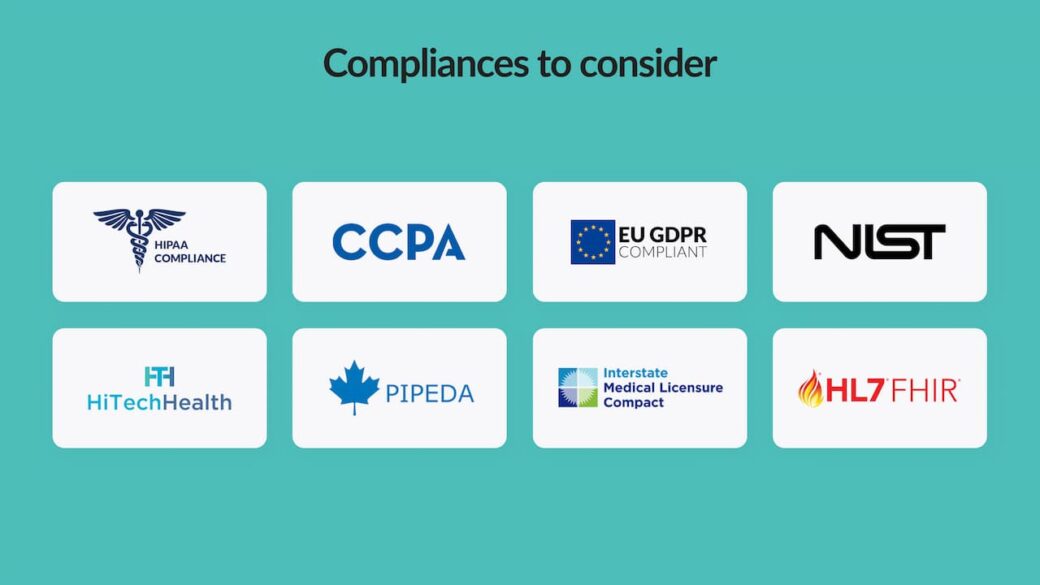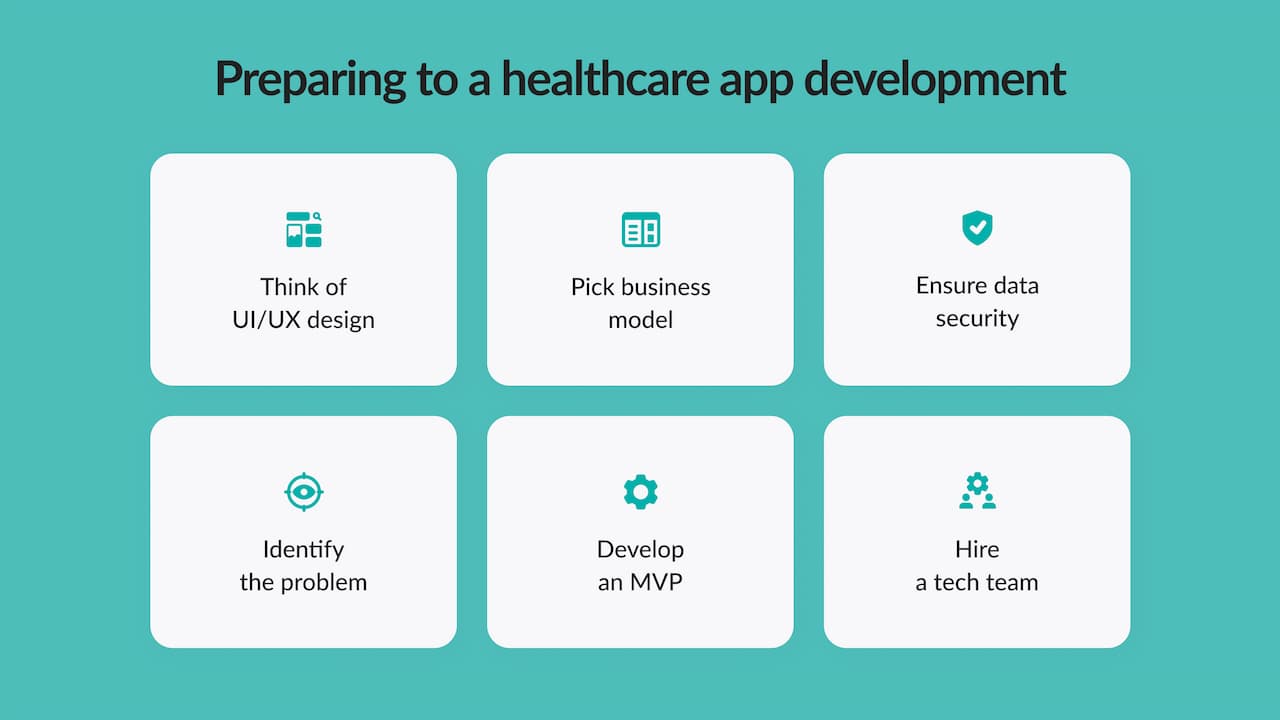Healthcare services inevitably go online. Telemedicine platforms are beneficial and time-saving, especially for modern people. Instead of waiting in a long queue or freeing time attending the clinics, people can make use of remote medical care. Such a growing demand for online medical services encourages entrepreneurs to create their own telemedicine solutions.
If you’re one of those who want to make use of the trend, this guide is for you. It reveals how to create a medical application, what types are out there, as well as implementation costs.
Variations of Telemedicine Platforms
The core objective of telemedicine software development services is to provide a safe and convenient environment to bridge the gap between doctors and patients. Therefore, medical solutions are split into two groups: patient- and doctor-centric apps. Each group includes its own set of digital solutions, the most popular ones we’ll describe below.
Patient-centric medical apps
- Mental health apps. They allow people to monitor various psychological concerns. Such digital solutions can be equipped with checkers to trace life signs (e.g., blood pressure, health rate, oxygen level) and enable progress monitoring and getting feedback.
- Remote patient monitoring software. This group consists of apps that employ IoT devices, such as pulse oximeters, wireless patches, heart rate monitors, etc., assisting medical providers in tracing patients’ well-being remotely. Based on the data collected, a personalized treatment plan is prepared.
- Nutrition apps. They enable the creation of adapted meal plans, and managing users’ eating habits to reach their health and fitness objectives.
Medical solutions for medical practitioners
Medical networking. Such apps provide support allowing medical providers to interact with colleagues and share their knowledge and expertise.
Medical billing software. Billing software is made to optimize and digitize billing-related activities to help doctors receive payment faster, boost workflow efficiency, reduce the amount of paperwork, keep patients’ data up-to-date, and more.
E-prescription apps. These apps simplify medicine prescription operations. The physicians can assign prescriptions to patients/pharmacies through mobile apps or websites.
How To Create a Patient-Centric Telehealth Platform
Healthcare app development is a tricky thing requiring a set of things to account for: solid data security, regulatory compliances, device interoperability, an experienced IT vendor, and more. So let’s see how to properly implement telemedicine solutions to bring the company success.
Identify the problem
The majority of business ideas fail because they simply don’t meet market needs. Therefore, before kicking off your own medical solution, do research to outline the challenges/needs you want to cover with your platform. For instance, you may want to create a fitness app to incentivize people to take care of their wellness. Or you’re planning to introduce a remote patient monitoring platform allowing the elderly to track their vital signs. Careful research will allow making a solution meeting end-users needs. Moreover, it’s good to scrutinize the market leaders to learn from their experience. Pay attention to their solid and, primarily, weak sides to determine a competitive edge.
Analyze your target audience
Before embarking on healthcare app building, you must know your target audience to deliver a relevant medical solution. Such apps can be made for varied age groups: children, teenagers, adults, or seniors. Indeed, you may build a platform covering all the target users’ needs. Using as many filters as you can define your target users will help you establish your medical app in the long run. You can start with online research to find, analyze, and gather data of a big group of people. Preliminary, the audience can be segmented by age, gender, location, and language. Then you can delve into details: behavior, values, habits, struggles, etc.
Consider robust data security
The healthcare niche is a tidbit for cybercriminals. Thus, it’s vital to consider all the security measures to guarantee top-level security of patients’ info. Bypassing pivotal security actions may result in colossal financial losses and concerns with laws. Initially, you must ensure your healthcare app adheres to niche-related regulatory compliances, such as HIPAA, PIPEDA, NIST, and other country-specific laws.

Decide on UI/UX design
Many startups find an idea, start developing their digital products instantly and then fail because the user interface runs counter to customers’ expectations. Even though the design stage is a vast space for creativity, the medical platforms’ look should stay straightforward. It needs to assist users in taking the core actions (e.g., schedule a consultation, request lab results), not distract them by artsy interface elements.
Select a revenue model
You should also choose a monetization model to ensure a steady revenue stream. There are various ways to generate money with your mHealth app, including freemium (e.g., trial periods), subscriptions, advertising, links with related services, and more. Remember, to raise income within the chosen business model, ensure your solution is well-designed and legislation-compliant with clear correlations between system modules.
Hire an experienced tech team
The successful telehealth app implementation will depend on the professional level of the selected IT vendor. When looking for an IT company, pay attention to its expertise. The software development agencies specialized in fintech app development, with less chance of being able to deliver a compliant-based healthcare app. The question is, where to find app developers to succeed? There are many professional platforms, like Clutch and GoodFirms, that provide a list of IT organizations. You can browse the companies’ profiles and receive information about services offered, project budget, and real clients’ feedback.
Develop an MVP
Telemedicine software solutions are complex interconnected systems that must be developed based on a step-step approach. Therefore, it’s better to start with MVP building (minimum viable product) to test the waters and collect users’ feedback. MVP medical platform stands for the software solution with limited features required to ensure the app’s operability and satisfy core patients’ needs (e.g., sign in, look for the therapist, schedule a consultation). After you confirm your idea’s viability, you can invest in developing a more sophisticated mHealth platform and integrate it with other business solutions, such as EHR, CRM, etc.
Average Cost to Build Telemedicine Apps
To put it in short, the price of creating integrated telemedicine platforms ranges from $40,000-$200,000+. So why is there such a run-up in prices? The reason is that medical project prices are affected by many factors, including the project’s complexity, number of features, custom design, APIs integrations, and more. Therefore, the dedicated team needs to scrutinize your initial requirements to receive an accurate project cost estimate.
The final price is also affected by the location of app engineers since the hourly rates vary depending on the region. For example, US software developers charge $100-$150 per hour. India is a good option if you’re looking for the lowest price. For example, the services of a senior programmer could cost $30/hour. However, a high price doesn’t equal excellent quality, just like a lower price doesn’t mean bad outcomes. Central and Northern Europe is considered the best region for the price-quality ratio. There are many competent IT companies that offer software development services for $50-$80/hour without sacrificing on end-quality. Indeed, nothing prevents you from collaborating with local experts. However, due to the project’s complexity, finding the required expertise in the local market may be tricky. In this case, you can apply for IT outsourcing services.
Summing Up
Telehealth mobile app building requires strict goals, thorough planning, and a well-thought implementation strategy. Even though it demands significant investment, healthcare is a sought-after niche, and all the expenses will pay off instantly.



